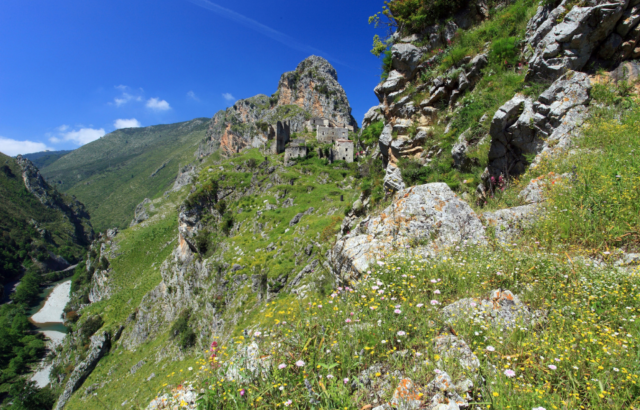At the top of a hill in the Province of Salerno, Italy, there are ruins of a medieval village called San Severino di Centola. Historically also known as San Severino di Camerota, the village contains a castle, cathedral, various houses, and cobblestone roads. If you were to visit the village and think it looks like a ghost town, then the local government has done its job right.
The early years

The village was founded during the 11th century. The Longobards, or Lombards, built a castle at the top of a hill above the stretching valleys. The Mingardo River runs through the dramatic landscape, which saw its first inhabitants in the 7th century when Bulgarian mercenaries arrived. The importance of the strategic site saw it taken by the Normans, the Swabians, and the Kingdom of Aragon.
Even though their location was strategic, life for those in the village was not always easy. The village was devastated by the plague during the 17th century, and farming was extremely difficult due to the landscape, so the village’s main crops were figs and walnuts.
In the 1960s, during postwar industrialization, the Italian government funded a project for a tunnel to be dug through the nearby mountains, expanding the railway. Seeking work on this construction project, many of the villagers left to live at the bottom of the hills. This opened the floodgates, and by the mid-1970s, no one called San Severino di Centola home.
The wilderness years

The medieval village, now abandoned, began to show neglect. Vegetation became overgrown and scaled the walls. The buildings themselves, largely intact, slowly began to decay, the odd roof collapsing, windows broken, and door missing. Even the cobblestone streets began to be shifted and moved by the roots of plants growing underneath.
San Severino di Centola was just one in a list of abandoned villages in the area. The Campania region became defined by the existence of these abandoned spaces in the region’s rocky and rugged terrain. Realizing this, the municipal government of Centola created the “Campania’s Regional Network of Abandoned Towns” in 2015.
The purpose of this network is to preserve the villages as they are. The hope is that it will garner investments and ways to maintain the unique sites in all their eerie glory. Here, the preservation of ghost towns is more important than revitalization. As Giuseppe Ottaiano, who maintains a database of unique sites around the area, told Atlas Obscura, “These are areas in which abandoned towns have become an integral part of the scenery. They represent the historical and anthropological identity of our territory”

Despite interest from a Rome-based real estate company in the 1980s, San Severino di Centola has remained largely untouched. Silverio D’Angelo, a former councilor for the Centola government, said, “We did not want someone coming in and destroying medieval houses to maybe build a new hotel… We wanted for San Severino to remain in the hands of people who had a tie to the village.”
To keep it as ‘ghostly’ as possible while making it safe and accessible to visit, members have taken on low-cost maintenance activities such as weeding and clearing pathways. And with the establishment of a nonprofit, Il Borgo (The Hamlet), the abandoned town has become the site of various events, including “live nativity scenes around Christmas… small concerts, poetry readings, and open-air concert sessions.”
The future of San Severino di Centola

It is reported that the long-term plan for San Severino is to transform it into an arts and culture center, which would see some of the abandoned homes turned into workshops. D’Angelo said, “We lack the budget to do that right now but that would be our goal. We would love to see artists from around the country coming here to work.”
More from us: Is the Villa de Vecchi the Most Haunted House in Italy?
The ghost town of San Severino di Centola is a vitally important part of the community. Geppino Amorelli, who lived in the town until the 1960s, said, “When people talk about preserving a place, it’s really about preserving people’s ties to that place… If that tie is kept alive, so will the identity of the town.”
